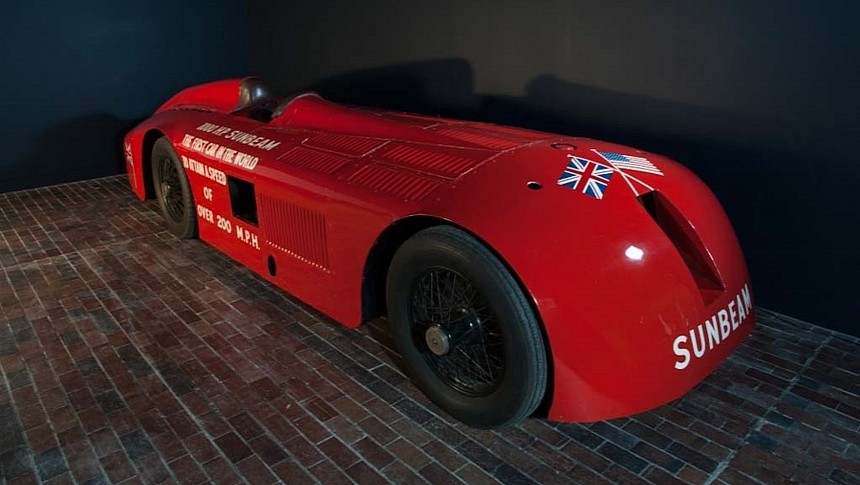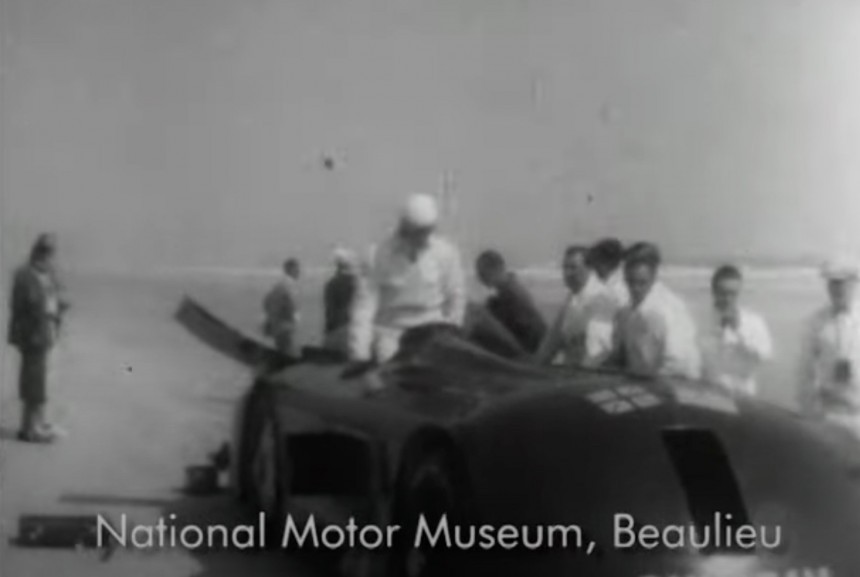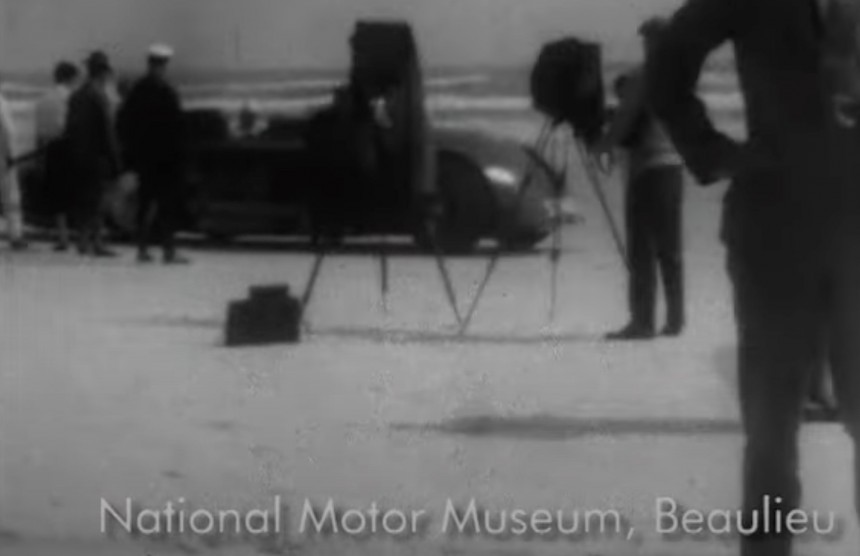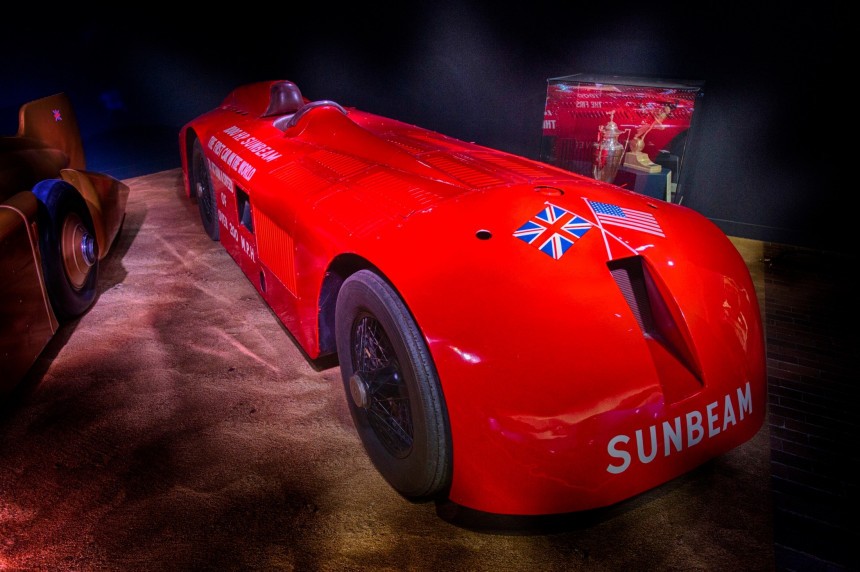This was a land speed record-breaker. It was the pride and joy of Sunbeam. It had aircraft engines, it had the streamliner silhouette, and it was painted in red. It came with all the credentials that would throw it straight into the spotlight and into history. Now, almost 80 years since those engines last started, the car is being restored with the help of a fundraising campaign.
Land Speed Sunbeam 1000 hp was The Slug. It was actually the ironic and affectionate tag for the car that was specifically designed to break the land record. The model saw the light of day in the Sunbeam factory in Wolverhampton. It was powered by two aircraft engines that were set to make it travel at over 200 mph (322 kph). It may not sound like much by today's standards. But back then, it was a massive innovation.
Those engines are a pair of Sunbeam Matabele aircraft units, which had previously been used in a powerboat. They had a capacity of 22.4 liters and generated 435 horsepower each, which was below 900 horsepower. But the name of the vehicle was always accompanied by the more spectacular '1000 hp' line.
One of the power plants was installed in front of the driver, and another one found room behind him. The rear one started first by compressed air. The one at the front roared to life through a mechanical friction clutch. Once they would synchronize, they would be locked together with a dog clutch.
The last time the wheels of the Land Speed Sunbeam span was during a demonstration at Brooklands. The model only ran on a single engine at a very low speed. That was all it could do. Today, it resides at the National Motor Museum in Beaulieu, a village in England. But it is far from what it used to be nine decades ago.
British automobile engineer John Samuel Irving designed the car. His team and soon everyone else called him Captain Jack Irving upon his request. He came up with the all-enveloping bodywork that gave a helping hand to aerodynamics.
The model was fitted with specially made tires that were capable of withstanding that huge speed of 200 mph. But… there is always a 'but.' Those tires could only resist for three and a half minutes at such a high speed.
Even though it could flash over land, the model was not entirely innovations. Captain Jack Irving also brought in somewhat of a primitive mechanism. A pair of chains connected the final drive to the rear axle.
The development of the vehicle was overshadowed by controversy. In preparation for the record attempt, it was speculated that racing driver J.G. Parry-Thomas had been decapitated when such a chain that his car, Babs, was fitted with, broke at speed on March 3, 1927. But the investigation of the recovered wreckage showed that the rear right-hand wheel had failed and caused Babs to overturn.
Furthermore, during the process of restoration, it was found that the first scenario based on speculation could have simply been impossible. The chains were enclosed under an armored steel case. Most likely, Parry-Thomas was killed as a result of the injuries he sustained during the rollover at more than 100 mph (160 kph).
The driver was buried in St. Mary's Churchyard in Byfleet, Surrey, not far from the Brooklands Circuit. Babs was buried in the dunes at Pendine Sands, where the accident had taken place, and everyone thought that the story would end right then and there.
But the car was controversially excavated out of its sand tomb 42 years later, in 1969, and ended up in the hands of Welsh automobile restorer and mechanic Owen Wyn Owen, then a member of the Bangor University. He ignored all the criticism and worked on what was to become his most famous and ambitious project ever.
Meanwhile, the car was on display at the Pendine Museum of Speed until the demolition of the venue in 2020. After a new restoration process, it returned to the spotlight at the new Sand of Speed Museum. But the mechanicals still needed thorough work.
Meanwhile, the Land Speed Sunbeam was going through its own process of restoration. The National Motor Museum at Beaulieu managed to reach the 50,000-pound ($63,781 at the current exchange rates) mark with its campaign. A special fundraising event will take place on January 27, and all proceeds will go into making this record-breaker run once again.
The museum is seeking further financial support to get to the next stage of the restoration. It is the stage where the team will finally fire up the engines that last ran before World War II. Attacked by corrosion over these past eight decades, they are going to need a lot of work to spin back to life.
The team's target is to take this car to Daytona, in the United States, for the centenary of its record from 2027. They also want to take it on a tour across Europe and America, display it in museums, schools, colleges, and universities, and everywhere it might make a crowd buzz around it. Because this car has quite a story to tell.
The Sunbeam 1000 HP was the first non-American car to compete on Daytona Beach for Aland speed record attempt. It broke the record on March 29, 1927, with Henry Segrave at the helm. It hit 203.79 mph (327.97 kph) and became the first car to go over the 200 mph (320 kph) barrier.
Those engines are a pair of Sunbeam Matabele aircraft units, which had previously been used in a powerboat. They had a capacity of 22.4 liters and generated 435 horsepower each, which was below 900 horsepower. But the name of the vehicle was always accompanied by the more spectacular '1000 hp' line.
One of the power plants was installed in front of the driver, and another one found room behind him. The rear one started first by compressed air. The one at the front roared to life through a mechanical friction clutch. Once they would synchronize, they would be locked together with a dog clutch.
The last time the wheels of the Land Speed Sunbeam span was during a demonstration at Brooklands. The model only ran on a single engine at a very low speed. That was all it could do. Today, it resides at the National Motor Museum in Beaulieu, a village in England. But it is far from what it used to be nine decades ago.
The model was fitted with specially made tires that were capable of withstanding that huge speed of 200 mph. But… there is always a 'but.' Those tires could only resist for three and a half minutes at such a high speed.
Even though it could flash over land, the model was not entirely innovations. Captain Jack Irving also brought in somewhat of a primitive mechanism. A pair of chains connected the final drive to the rear axle.
The development of the vehicle was overshadowed by controversy. In preparation for the record attempt, it was speculated that racing driver J.G. Parry-Thomas had been decapitated when such a chain that his car, Babs, was fitted with, broke at speed on March 3, 1927. But the investigation of the recovered wreckage showed that the rear right-hand wheel had failed and caused Babs to overturn.
Furthermore, during the process of restoration, it was found that the first scenario based on speculation could have simply been impossible. The chains were enclosed under an armored steel case. Most likely, Parry-Thomas was killed as a result of the injuries he sustained during the rollover at more than 100 mph (160 kph).
But the car was controversially excavated out of its sand tomb 42 years later, in 1969, and ended up in the hands of Welsh automobile restorer and mechanic Owen Wyn Owen, then a member of the Bangor University. He ignored all the criticism and worked on what was to become his most famous and ambitious project ever.
Meanwhile, the car was on display at the Pendine Museum of Speed until the demolition of the venue in 2020. After a new restoration process, it returned to the spotlight at the new Sand of Speed Museum. But the mechanicals still needed thorough work.
Meanwhile, the Land Speed Sunbeam was going through its own process of restoration. The National Motor Museum at Beaulieu managed to reach the 50,000-pound ($63,781 at the current exchange rates) mark with its campaign. A special fundraising event will take place on January 27, and all proceeds will go into making this record-breaker run once again.
The team's target is to take this car to Daytona, in the United States, for the centenary of its record from 2027. They also want to take it on a tour across Europe and America, display it in museums, schools, colleges, and universities, and everywhere it might make a crowd buzz around it. Because this car has quite a story to tell.
The Sunbeam 1000 HP was the first non-American car to compete on Daytona Beach for Aland speed record attempt. It broke the record on March 29, 1927, with Henry Segrave at the helm. It hit 203.79 mph (327.97 kph) and became the first car to go over the 200 mph (320 kph) barrier.









